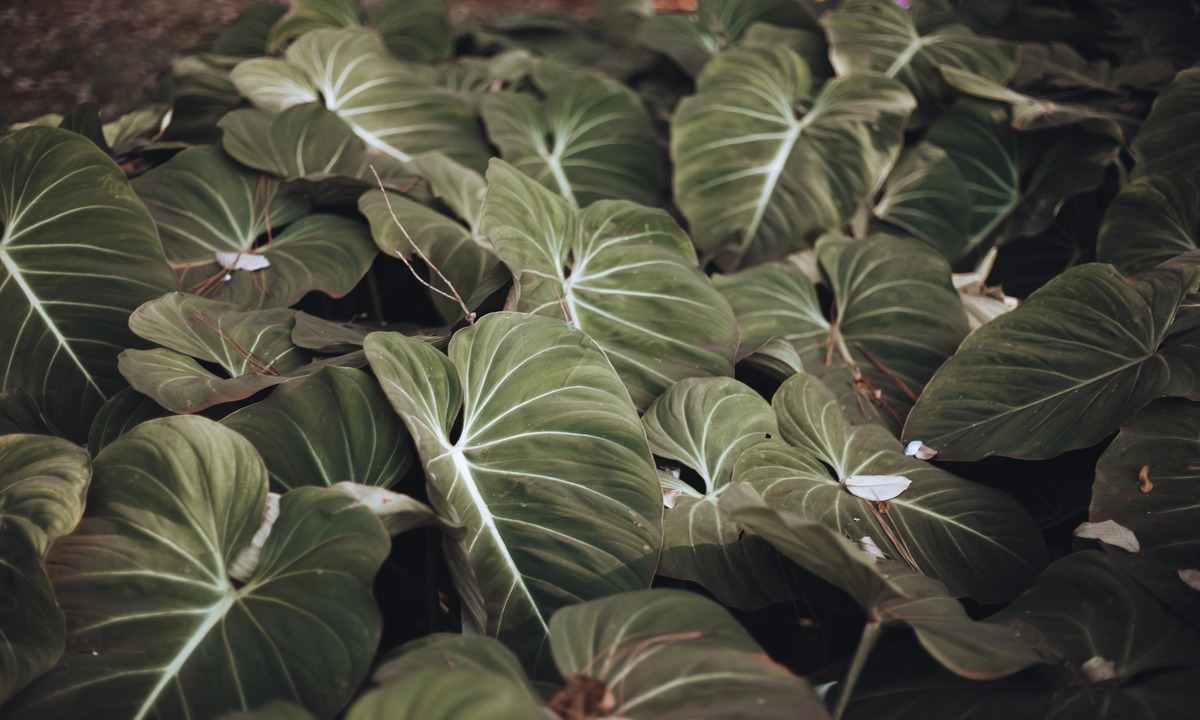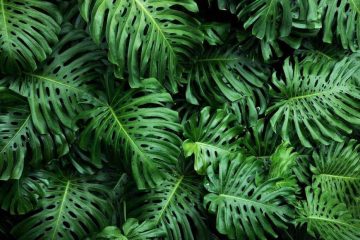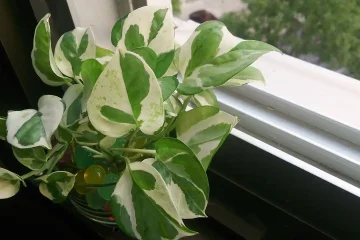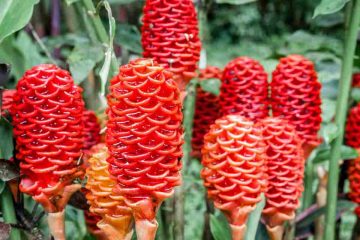So, you’ve got your eyes set on the stunning Philodendron Melanochrysum, huh? Well, buckle up because you’re in for a treat! This tropical beauty is a sight to behold with its velvety, heart-shaped leaves that boast a deep, rich green hue. But let’s be real, keeping this plant thriving requires a bit of TLC. Fear not, though, because I’m here to spill the beans on how to grow and care for your Philodendron Melanochrysum like a pro. From light requirements to watering schedules, Plants Fiesta has covered it all to ensure your plant becomes the envy of every green-thumb enthusiast out there!
| Attribute | Description |
|---|---|
| Common Name | Black-gold philodendron, melano plant |
| Botanical Name | Philodendron melanochrysum |
| Family | Araceae |
| Plant Type | Perennial, vine |
| Mature Size | Indoors: 3-5 ft. tall, 1-2 ft. wide<br/>Outdoors: 12 ft. tall, 8 ft. wide |
| Sun Exposure | Partial |
| Soil Type | Loamy, moist but well-drained |
| Soil pH | Acidic |
| Bloom Time | Summer |
| Flower Color | Green, white |
| Hardiness Zones | USDA: 9-11 |
| Native Area | South America |
| Toxicity | Toxic to humans and animals |
How To Grow & Care Philodendron Melanochrysum (Complete Process)
Philodendron Melanochrysum is a stunning tropical plant known for its large, velvety leaves. Here’s a guide on how to grow and care for Philodendron Melanochrysum:

Light
Proper lighting is crucial for the health and growth of Philodendron Melanochrysum. This tropical plant thrives in bright, indirect light, which mimics its natural habitat beneath the canopy of trees in the rainforest. Direct sunlight can scorch its large, velvety leaves, causing damage. Placing the plant near a window with filtered sunlight or providing artificial light sources like grow lights can ensure it receives adequate illumination. Monitoring the intensity and duration of light exposure helps maintain optimal conditions for photosynthesis and overall plant vigor. Adequate light fosters lush foliage and vibrant growth, enhancing the beauty of this striking houseplant.
Temperature:
Philodendron Melanochrysum prefers temperatures between 65°F to 80°F (18°C to 27°C) to thrive. This tropical plant is sensitive to cold drafts, so it’s essential to keep it away from areas with temperatures below 55°F (13°C). Maintaining a consistent temperature within its preferred range promotes healthy growth and prevents stress on the plant. Warmer temperatures encourage active growth, while cooler temperatures can slow down growth or even cause damage. By providing the ideal temperature conditions, you can create a comfortable environment for your Philodendron Melanochrysum to flourish and display its stunning foliage.
Humidity:
Philodendron Melanochrysum thrives in high humidity environments, reminiscent of its native tropical habitat. Ideally, maintain humidity levels between 60% to 80% to ensure optimal growth and health. In lower humidity conditions, which are common indoors, you can increase moisture around the plant by misting its leaves regularly or placing it on a pebble tray filled with water. Additionally, using a humidifier in the room can help maintain consistent humidity levels. High humidity prevents the plant’s leaves from drying out and promotes lush, vibrant foliage. By providing adequate humidity, you can create an environment that mimics the plant’s natural rainforest habitat, fostering its growth and beauty. Philodendron Melanochrysum has a close relation to the Rainbow Elephant Bush, as they both belong to the Araceae family, though they differ vastly in appearance and care needs. The Rainbow Elephant Bush (Portulacaria afra ‘Variegata’) is a succulent known for its colorful foliage and drought tolerance.
Watering:
Proper watering is essential for the health of Philodendron Melanochrysum. Water the plant when the top inch of the soil feels dry to the touch, typically every 7-10 days. Ensure thorough watering, allowing excess water to drain from the pot’s bottom to prevent waterlogging, which can lead to root rot. Adjust watering frequency based on environmental conditions; for instance, increase watering during warmer months or if the plant is placed in a drier location. Always use room temperature water to avoid shocking the plant. Consistent and mindful watering practices contribute to the overall well-being and lush growth of Philodendron Melanochrysum.
Soil:
Philodendron Melanochrysum thrives in well-draining, aerated soil rich in organic matter. A mix of peat moss, perlite, and orchid bark provides an ideal growing medium. This type of soil retains moisture while allowing excess water to drain freely, preventing waterlogged conditions that can lead to root rot. When repotting, ensure the new pot has drainage holes to facilitate proper drainage. Periodically check the soil’s condition to ensure it hasn’t become compacted, which can impede drainage and root health. By using a suitable soil mix, you can provide an optimal growing environment for Philodendron Melanochrysum, promoting robust growth and lush foliage. Philodendron Melanochrysum and Philodendron Rugosum originate from the tropical forests of Central and South America, boasting velvety, heart-shaped leaves with prominent veining. Their growth patterns exhibit a climbing tendency, utilizing aerial roots to anchor themselves onto trees or surfaces. Both species thrive in warm, humid environments with indirect sunlight, displaying a preference for well-draining soil
Fertilizing:
Regular fertilization is essential for the healthy growth of Philodendron Melanochrysum. During the growing season in spring and summer, feed the plant with a balanced liquid fertilizer diluted to half strength every 4-6 weeks. Choose a fertilizer specifically formulated for houseplants or tropical foliage plants. Avoid fertilizing during the plant’s dormant period in winter. Over-fertilization can lead to salt buildup in the soil, causing damage to the plant’s roots. Consistent and appropriate fertilization provides the necessary nutrients for lush foliage and vibrant growth, enhancing the beauty of Philodendron Melanochrysum.
Support:
As Philodendron Melanochrysum grows, it may benefit from additional support to encourage upward growth and prevent sprawling. Install a moss pole, trellis, or stake near the plant to provide support for its vines. Secure the plant to the support structure using soft ties or twine, avoiding any damage to the stems. Regularly adjust the ties as the plant grows to ensure proper support. Supporting Philodendron Melanochrysum encourages vertical growth and prevents it from taking up excessive space. Additionally, it enhances the plant’s aesthetic appeal by showcasing its beautiful foliage.
Propagation:
Philodendron Melanochrysum can be propagated through stem cuttings. Using clean, sharp scissors or pruners, cut a healthy stem with at least one node, preferably with several leaves attached. Remove any leaves from the lower portion of the cutting to expose the node. Place the cutting in water or a moist potting mix, ensuring the node is submerged or buried. Keep the cutting in a warm, humid environment with indirect light. Roots should begin to develop within a few weeks. Once roots are established, transplant the cutting into a separate pot filled with well-draining soil. Philodendron Melanochrysum shares similarities with Swiss Cheese Plants (Monstera deliciosa) as both belong to the Araceae family, showcasing lush foliage and easy-care requirements. While Swiss Cheese Plants boast iconic fenestrated leaves, Philodendron Melanochrysum captivates with its rich, velvety texture, adding depth to any indoor jungle.
Repotting:
Repot Philodendron Melanochrysum into a slightly larger pot when it becomes root-bound, typically every 1-2 years. Spring is the best time for repotting when the plant is actively growing. Select a pot that provides ample room for the plant’s roots to spread out. Ensure the new pot has drainage holes to prevent waterlogging. Gently loosen the plant’s roots and place it in the center of the new pot. Fill the remaining space with fresh, well-draining potting mix, pressing it down lightly around the plant. Water the plant thoroughly after repotting to help settle the soil. Repotting allows Philodendron Melanochrysum to continue thriving and prevents root congestion, promoting healthy growth and development.
Philodendron Melanochrysum Types
Philodendron ‘Glorious’:
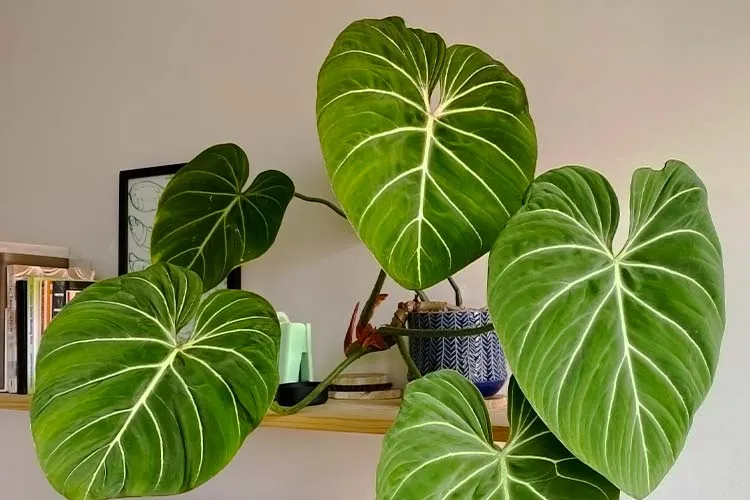
So, let’s talk about Philodendron ‘Glorious’. This beauty is a hybrid of Philodendron gloriosum and Philodendron melanochrysum. Picture this: velvety leaves with this lush, luxurious texture, and veins that pop out in a stunning white hue against the rich green backdrop. It’s like having a piece of elegant artwork right in your home. This hybrid is a real showstopper, perfect for adding a touch of sophistication to any space. Plus, taking care of it is a breeze, making it even more glorious to have around.
Philodendron ‘Splendid’:
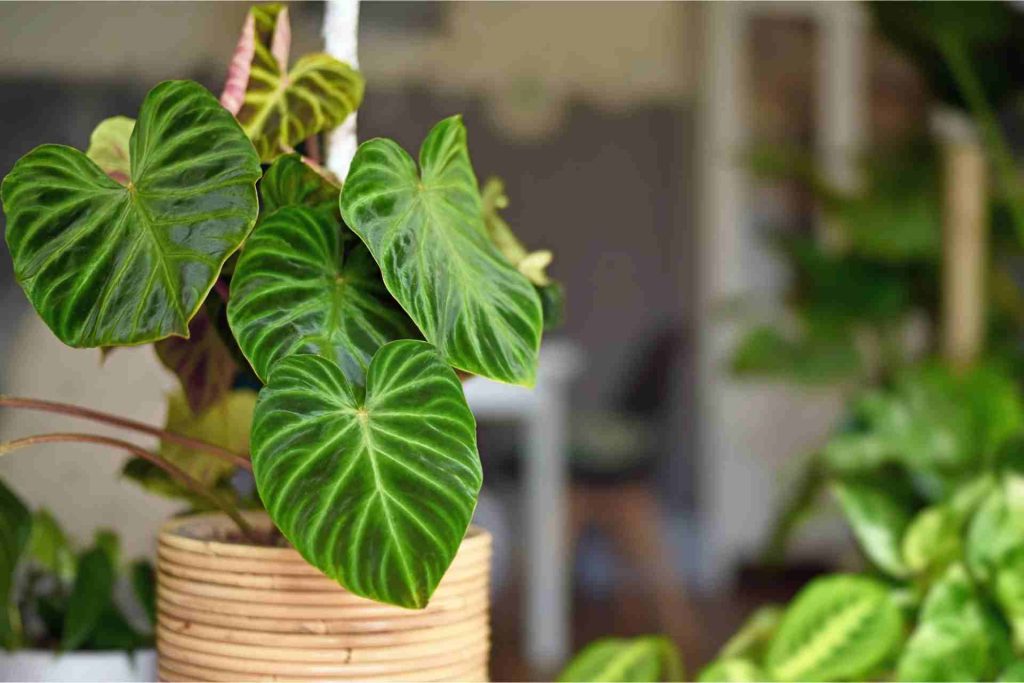
Now, let’s chat about Philodendron ‘Splendid’. This one’s a hybrid of Philodendron verrucosum and Philodendron melanochrysum, and let me tell you, it lives up to its name. Imagine velvet-like leaves that seem to shimmer with an iridescent sheen, casting a magical aura wherever they’re placed. It’s like having a piece of the rainforest right in your living room. The velvety texture adds depth, while that subtle iridescence brings a touch of whimsy. With its unique look and relatively easy care routine, Philodendron ‘Splendid’ is sure to steal the spotlight in any plant collection.
Philodendron ‘Black Gold’:
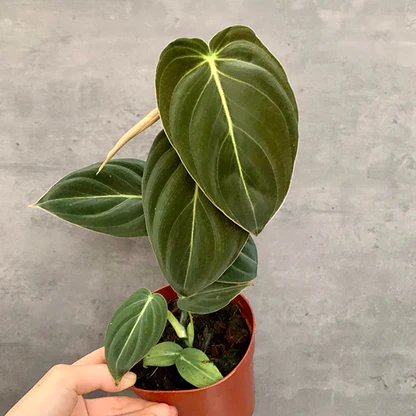
Imagine a plant that seems dipped in molten gold, with deep, dark leaves that shimmer with a metallic sheen. That’s Philodendron ‘Black Gold’ for you. This hybrid of Philodendron melanochrysum and Philodendron billietiae is a sight to behold. Its leaves start out a rich, velvety green, but as they mature, they take on a striking blackish hue with golden veins running through them. It’s like having a piece of treasure right in your home, and caring for it is just as rewarding as admiring its stunning appearance.
Philodendron ‘Narrow Escape’:
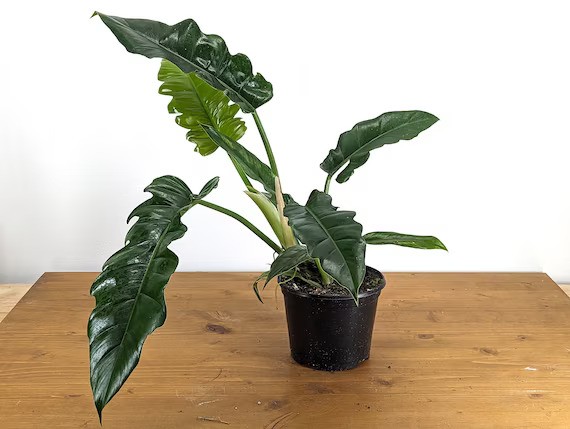
Philodendron ‘Narrow Escape’ is another captivating variety. It’s a hybrid of Philodendron melanochrysum and Philodendron verrucosum. As the name suggests, its leaves have a unique elongated shape, making them stand out from other Philodendron varieties. The velvety texture is still there, but with a twist – the leaves are narrower, giving the plant a more elegant and streamlined appearance. Despite its exotic looks, ‘Narrow Escape’ is surprisingly easy to care for, making it a great choice for both beginner and experienced plant enthusiasts alike.
These additional types of Philodendron melanochrysum offer even more diversity and beauty to plant lovers, each with its own unique characteristics and charm.
Philodendron Melanochrysum Propagation
Propagating Philodendron Melanochrysum can be done through several methods, including stem cuttings, air layering, or division. Here’s a step-by-step guide on propagating Philodendron Melanochrysum using stem cuttings:
Materials Needed:
- Philodendron Melanochrysum plant
- Clean, sharp scissors or pruning shears
- Small pots or containers filled with well-draining potting mix
- Rooting hormone (optional)
- Plastic bags or a propagation tray to create a humid environment (optional)
- Watering can or spray bottle
Procedure:
- Preparation: Before you start, make sure your tools and containers are clean and sterilized to minimize the risk of introducing pathogens to the cuttings.
- Select Healthy Parent Plant: Choose a healthy Philodendron Melanochrysum plant with strong, mature stems. Avoid stems that are diseased or damaged.
- Take Cuttings: Using clean scissors or pruning shears, take several stem cuttings from the parent plant. Each cutting should ideally be 4-6 inches long and have at least one leaf node (where leaves emerge) present. It’s best to take cuttings just below a node.
- Remove Lower Leaves: Carefully remove the lower leaves from each cutting, leaving a clean stem. This helps to reduce moisture loss and prevents the leaves from rotting when placed in the propagation medium.
- Apply Rooting Hormone (Optional): Dip the cut end of each cutting into rooting hormone powder. This step is optional but can encourage faster root development.
- Plant Cuttings: Insert the cuttings into small pots or containers filled with moistened potting mix. Make sure at least one leaf node is buried in the soil, as this is where roots will emerge. Firmly press the soil around the base of the cutting to provide stability.
- Create Humid Environment (Optional): To maintain high humidity around the cuttings, you can cover the pots with plastic bags or place them in a propagation tray with a clear lid. This helps to prevent moisture loss and encourages root growth.
- Provide Indirect Light: Place the pots in a location with bright, indirect light. Avoid direct sunlight, as this can cause the cuttings to wilt or burn.
- Watering: Keep the potting mix consistently moist but not waterlogged. You can mist the cuttings with a spray bottle or water them from the bottom to avoid disturbing the cuttings.
- Monitor Growth: Over the next few weeks, monitor the cuttings regularly for signs of new growth and root development. Once roots have formed and the cuttings have established themselves (typically after 6-8 weeks), you can gradually acclimate them to normal growing conditions.
- Transplanting: Once the cuttings have developed a healthy root system and are actively growing, you can transplant them into larger pots with standard potting mix. Continue to care for them as you would mature Philodendron Melanochrysum plants.
By following these steps, you can successfully propagate Philodendron Melanochrysum from stem cuttings and expand your collection of these beautiful plants.
Common Pests:
- Spider Mites: These minuscule arachnids are notorious for infesting the undersides of Philodendron Melanochrysum leaves. They puncture leaf cells, leading to stippling, yellowing, and eventual leaf drop. Their rapid reproduction and ability to spin fine webs make them challenging to eradicate.
- Mealybugs: Resembling small cotton balls, mealybugs congregate in leaf axils and on the undersides of leaves, sucking sap from the plant. Their feeding weakens the plant and can lead to stunted growth and deformation.
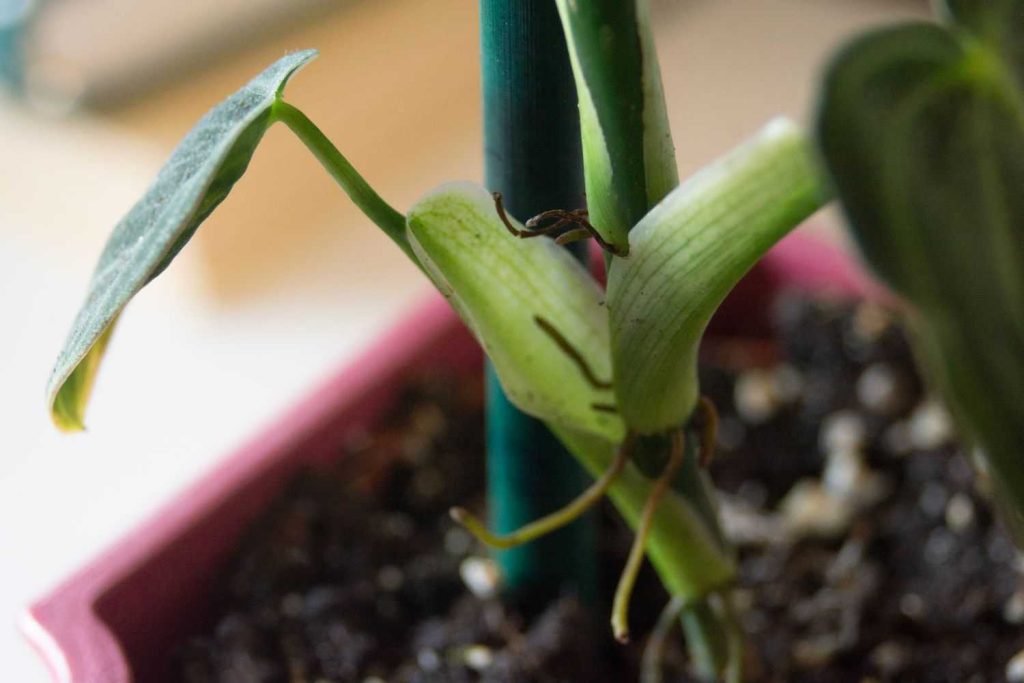
- Scale Insects: Scale insects appear as small, often brown or black, bumps on stems and leaves. They feed by piercing the plant and extracting sap, which can result in decreased plant vigor and growth.
- Aphids: These tiny, soft-bodied insects can quickly colonize new growth on the Philodendron Melanochrysum, sucking sap and causing distortion of leaves and shoots. Their feeding can also lead to the development of sticky honeydew, which attracts ants and promotes the growth of sooty mold.
- Thrips: Thrips are slender insects that feed on leaves and flowers by scraping the surface and sucking up the exuding sap. They leave behind silvery or brownish scars on leaves, which can lead to aesthetic damage and, in severe cases, reduced plant health and vigor.
Plant Diseases:
- Root Rot: One of the most common diseases affecting Philodendron Melanochrysum, root rot is caused by various fungi that thrive in excessively moist soil. Overwatering or poor drainage can lead to the development of root rot, which manifests as wilting, yellowing, and eventual collapse of the plant.
- Leaf Spot: Leaf spot diseases are typically caused by fungal pathogens that infect the foliage of the Philodendron Melanochrysum. These pathogens create dark spots on the leaves, which may enlarge over time and coalesce, leading to extensive leaf damage and premature leaf drop.
- Powdery Mildew: This fungal disease appears as a white, powdery growth on the leaves and stems of the Philodendron Melanochrysum. It thrives in warm, humid conditions and can quickly spread throughout the plant if left untreated, leading to reduced photosynthesis and overall plant vigor.
- Bacterial Blight: Bacterial blight is a bacterial disease that can affect the Philodendron Melanochrysum, causing dark, water-soaked lesions on the leaves and stems. As the disease progresses, these lesions may enlarge and coalesce, leading to extensive tissue damage, leaf yellowing, and eventual collapse of affected plant parts.
Common Problems With Philodendron Melanochrysum
Philodendron melanochrysum is a stunning tropical plant known for its large, velvety leaves and relatively low maintenance requirements. However, like any plant, it can encounter various problems. Here are some common issues with Philodendron melanochrysum and how to address them:
- Overwatering or underwatering: Both overwatering and underwatering can lead to problems like root rot or wilting. Ensure the plant is placed in well-draining soil and water it when the top inch of soil feels dry. Adjust watering frequency based on environmental conditions such as humidity and temperature.
- Pests: Common pests that can affect Philodendron melanochrysum include spider mites, aphids, mealybugs, and scale insects. Regularly inspect the leaves for any signs of pests such as webbing, tiny insects, or sticky residue. Treat infestations promptly with insecticidal soap or neem oil, and isolate the plant if necessary to prevent the pests from spreading.
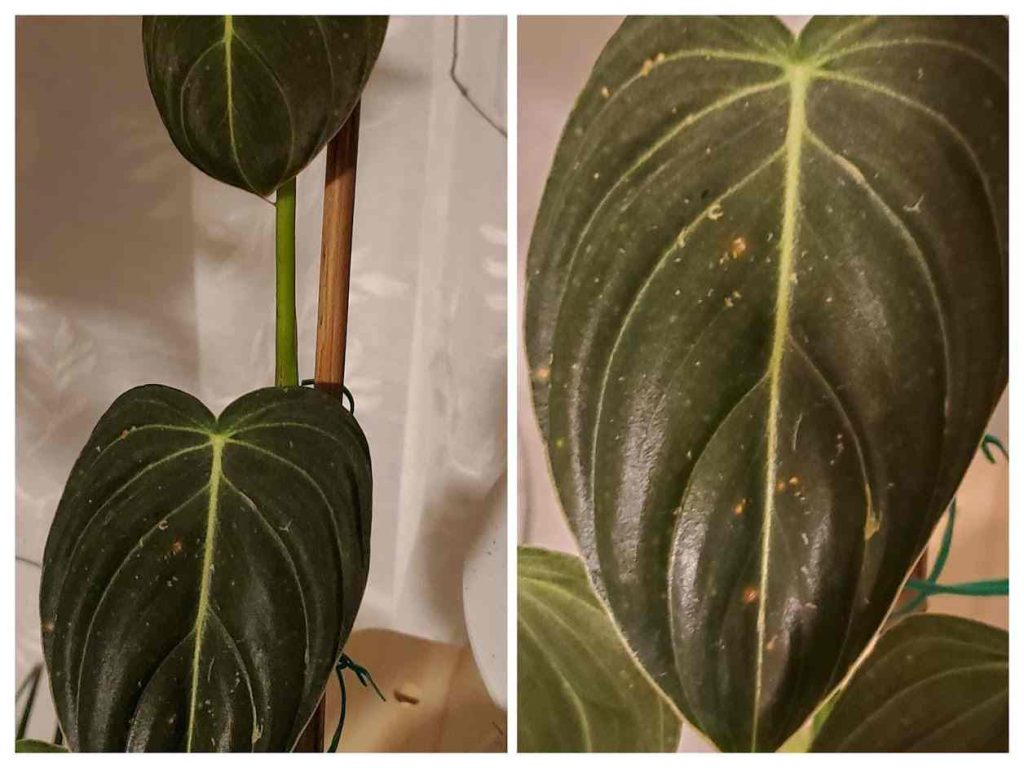
- Yellowing leaves: Yellowing leaves can be a sign of various issues, including overwatering, underwatering, nutrient deficiencies, or pests. Assess the plant’s watering schedule and soil moisture levels, ensure it is receiving adequate light (but not direct sunlight), and consider fertilizing with a balanced houseplant fertilizer to address nutrient deficiencies.
- Brown leaf tips or edges: Brown leaf tips or edges are often caused by low humidity, overfertilization, or exposure to dry air or drafts. Increase humidity around the plant by misting the leaves regularly, using a humidity tray, or placing a small humidifier nearby. Avoid overfertilizing, as excessive salts in the soil can burn the roots and lead to brown leaf edges.
- Leaf curling: Leaf curling can be caused by environmental stressors such as temperature fluctuations, inadequate watering, or pests. Ensure the plant is kept in a stable environment with consistent temperature and humidity levels. Monitor watering to prevent both over- and underwatering, and inspect the plant for signs of pests.
- Wilting: Wilting can be a sign of underwatering, overwatering, root rot, or pests. Check the soil moisture level and adjust watering accordingly. If the soil is consistently wet, consider repotting the plant into fresh, well-draining soil. Inspect the roots for any signs of rot and trim away any affected areas. Treat any pest infestations promptly.
- Slow growth: If your Philodendron melanochrysum is not growing as expected, it may be due to insufficient light, inadequate nutrients, or root-bound conditions. Ensure the plant is placed in bright, indirect light and consider fertilizing it with a balanced houseplant fertilizer during the growing season. If the plant has outgrown its current pot, consider repotting it into a slightly larger container to provide more space for root growth.

